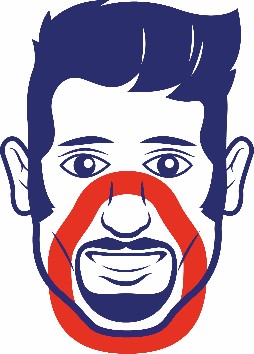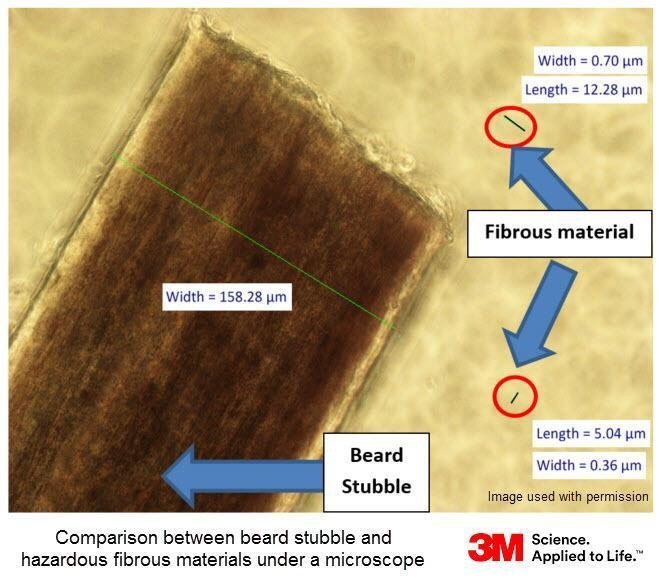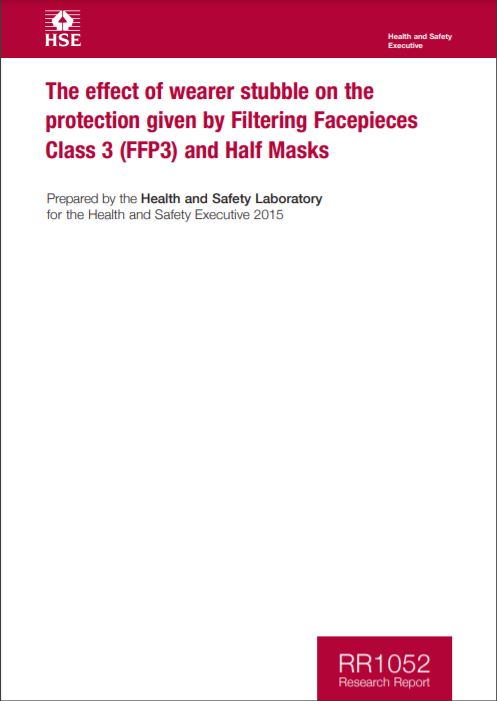Tight fitting respirator users must be clean shaven
Not only for a face fit test, but each and every time the respirator is used. This is because the presence of facial hair in the face seal area will compromise a seal being obtained. Any facial hair, including stubble, in the face seal area inevitably results in leakage.
Some facial hair is acceptable, but not where the mask makes contact with skin, such as a neat goattee or neat moustache.
The following images below show what is acceptable for both half masks and full face masks.


No, any tight fitting respirator requires a seal to the face to be effective. Facial hair compromises that seal and causes leakage and exposure to airborne contaminents.
All facial hair in the face seal area can compromise the seal being obtained, and stubble is actually the worst. Short hairs growing straight out from the face will prevent an effective seal from being obtained.
Either
a) Shave, so you can be face fit tested. You will then need to ensure you are clean shaven each and every time you wear a tight fitting respirator.
b) avoid exposure. If you can avoid environments and activities where respiratory hazards are present or may be generated – then you do not need to shave as you will not need respiratory protection
c) consider loose fitting respirator types which do not require a seal to the face to be effective
N.B. Anyone required to use self contained breathing apparatus (SCBA) must be clean shaven. There is no alternative product which offers the same level of protection. All SCBA users must be clean shaven and be face fit tested, otherwise they can not do the work which requires SCBA.
There is 2 sides to this argument.
1) Employees have a responsibility under Health & Safety Law to comply with safety measures and instructions. It could therefore be considered reasonable to expect employees to shave if tight fitting respirators are required for their work activity/environment.
2) There is other options for people with facial hair – i.e. loose fitting respirators
It is Face Fit Safety’s opinion that it would be reasonable to expect someone to shave in a large number of situations. However if the employee has styled facial hair, a full grown beard which they do not want to remove, or indeed for religous reasons or for skin conditions – then other options should be considered.
If a company has a clean shaven policy in place then this can be enforced.
Also if work requires the use of self contained breathing apparatus (SCBA), then this also requires the wearer to be clean shaven otherwise they can not carry out the work involving SCBA.
Clean shaven means that no facial hair should be visible in the face seal area. The HSE defination for being clean shaven is that employees should shave within 8 hours of starting their work shift.
Why does facial hair cause leakage?
It is an almost daily situation for the HSE and face fit testers, encountering employees wearing tight fitting respirators whilst having facial hair.
People don’t appreciate how much leakage occurs and how they can be exposed to breathing in airborne hazards. Almost daily when face fit testing we have someone with stubble, who asks why won’t you face fit test me? It’s only a little bit of growth? All facial hair causes the seal to tbe compromised and the respirator will not protect the wearer as intended. As can be seen in the image, people think human hairs are small – they are not! Compared to fine dusts and fibrous materials, human hair is massive in diamater hence you will be exposed to respiratory hazards if you are not clean shaven.


HSE Research Report on stubble & RPE
HSE Inspectors routinely come across workers with various degrees of stubble growth using respiratory protective masks, despite guidance to the contrary. This research studied the effect of 0-7 days stubble growth on the protection given by FFP3 filtering facepieces and half masks.
Fifteen male volunteers took part, each testing four masks. For most, three different design FFP3 and one half mask were tested, selected from seven models of FFP3 and 2 half masks. Fit tests were carried out immediately after shaving and repeated six times during the following week, without further shaving.
Results showed that the effect on protection was quite specific to the mask/wearer combination. Protection could be significantly reduced where stubble was present, beginning within 24 hours from shaving, and generally worsening as facial hair grew. Statistical analysis predicted this could reach an unacceptable level for all of the masks tested.
While some individual wearers did grow some stubble without significantly reducing protection with some masks, this was unpredictable and it would not be practical to conduct the necessary testing to confirm this for every individual wearer. The current guidance advising being clean-shaven in the area of the mask seal is justified.
To read the report in full
Loose fitting respirators
A loose fitting respirator system will utilise a motor, battery and filter to ensure clean air is drawn through a filter, sent via a breathing tube to a loose fitting headtop (hood or helmet). The constant flow rate of air entering the headtop provides the protection, rather than requiring a perfect seal to the face.
These respirator types can provide the same or higher protection than disposable respirators, or reusable half or full face masks used with filters.
N.B. They will not provide the same level of protection as self contained breathing apparatus (SCBA), hence SCBA users must be clean shaven, and face fit tested as there is no alternative product for people with facial hair.
Please get in touch should you require assistance selecting the correct respirator types for your requirement.

